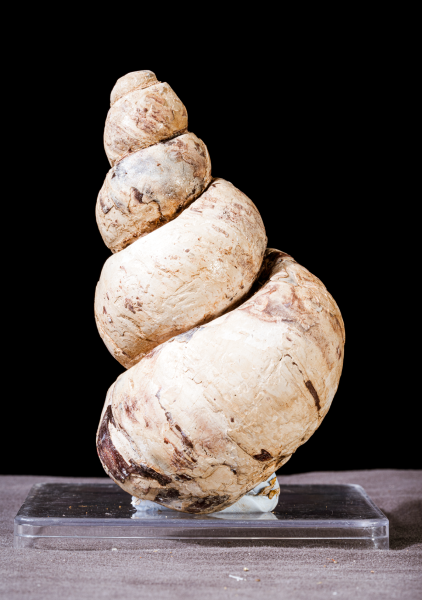
Ốc Na Dương
Na Duong Gastropod

Chân bụng (Ốc) là loại hóa thạch tiêu biểu nhất của phần cao địa tầng vùng Na Dương, chúng có tuổi Oligocen muộn, cách đây 28 – 23 triệu năm. Có những chỗ chúng tích tụ tầng tầng lớp lớp tới mức độ tạo đá, biến trầm tích dưới lòng hồ trở thành trầm tích sinh học tức trầm tích có chứa hóa thạch. Hóa thạch ốc tại Na Dương chủ yếu thuộc về dạng Viviparus cf. margaryaeformis, một loài do H. Mansuy xác lập năm 1918. Những con trưởng thành có kích thước đạt tới 10-12 cm, vỏ chuyển màu trắng khi hóa thạch, nổi bật trên nền màu xám nâu của trầm tích bao quanh.
Ốc thuộc lớp Chân bụng (Gastropoda) là một lớp đông đảo (có tới 80.000 loài hiện đại) và là lớp duy nhất trong ngành Thân mềm sống ở cả trên cạn và dưới nước. Đầu của chúng được tách biệt khá rõ ràng khỏi mình, chân có dạng đế dùng để bò trên mặt đáy.
Đại đa số động vật Chân bụng có vỏ cứng, một số Chân bụng sống ở trên cạn và dưới nước không có vỏ. Các nhà khoa học phân biệt ba dạng vỏ chính: dạng nón, dạng xoắn dẹt và dạng xoắn ốc. Những mẫu hóa thạch Chân bụng gặp ở Na Dương đều thuộc loại xoắn ốc (kiểu ốc sên).
Vỏ hình xoắn ốc là loại vỏ đặc trưng nhất đối với động vật Chân bụng. Một vòng xoắn đầy đủ tạo nên một vòng ốc được cuộn xoắn theo kiểu đinh vít. Hóa thạch Ốc Viviparus tại Na Dương thường có 4 vòng xoắn, có những mẫu đạt tới 5 vòng xoắn thuộc loại vỏ nhiều vòng.
Hóa thạch Chân bụng Viviparus cf. margaryaeformis – Phát hiện tại: Mỏ than Na Dương, Lạng Sơn, Việt Nam – Tuổi: Oligocen (28-23 triệu năm)
Gastropoda (Snail) are the most typical fossil of the high stratigraphy of Na Duong region, late Oligocene age, during the period of 28-23 million years ago. There are places where they accumulate layers and layers to the level of rock formation, turning the sediments in the lake bed into biological sediments, or fossil-containing deposits. Snails fossils in Na Duong is a species name Viviparus cf. margaryaeformis was established in 1918 by H. Mansuy. Adults reach 10-12 cm in size, the shell turns white when fossilized, standing out against the gray-brown background of the surrounding sediments.
The gastropod snails (Gastropoda) are a large class (with up to 80,000 modern species) and the only class in the phylum Molluscs that inhabit both land and water. Their heads are quite clearly separated from their bodies, their feet have soles used to crawl on the bottom.
A snail is, in loose terms, a shelled gastropod. Gastropods that naturally lack a shell, or have only an internal shell, are mostly called slugs, and land snails that have only a very small shell (that they cannot retract into) are often called semi-slugs.
Spiral shells are the most typical shell for gastropods. A full helix forms a screw-wound spiral. Viviparus snail fossils in Na Duong usually have 4 helices; some samples reach 5 helices of multi-ring shells.
Gastropoda (Snail) are the most typical fossil of the high stratigraphy of Na Duong region, late Oligocene age, during the period of 28-23 million years ago. There are places where they accumulate layers and layers to the level of rock formation, turning the sediments in the lake bed into biological sediments, or fossil-containing deposits. Snails fossils in Na Duong is a species name Viviparus cf. margaryaeformis was established in 1918 by H. Mansuy. Adults reach 10 – 12cm in size, the shell turns white when fossilized, standing out against the gray-brown background of the surrounding sediments.
The gastropod snails (Gastropoda) are a large class (with up to 80,000 modern species) and the only class in the phylum Molluscs that inhabit both land and water. Their heads are quite clearly separated from their bodies, their feet have soles used to crawl on the bottom.
A snail is, in loose terms, a shelled gastropod. Gastropods that naturally lack a shell, or have only an internal shell, are mostly called slugs, and land snails that have only a very small shell (that they cannot retract into) are often called semi-slugs.
Spiral shells are the most typical shell for gastropods. A full helix forms a screw-wound spiral. Viviparus snail fossils in Na Duong usually have 4 helices; some samples reach 5 helices of multi-ring shells.
Gastropoda fossil Viviparus cf. margaryaeformis – Found at: Na Duong coal mine, Lang Sơn, Vietnam – Age: Oligocene (28-23 million years ago)
Bảo tàng Hóa thạch Hà Nội
Hanoi Fossil Museum

